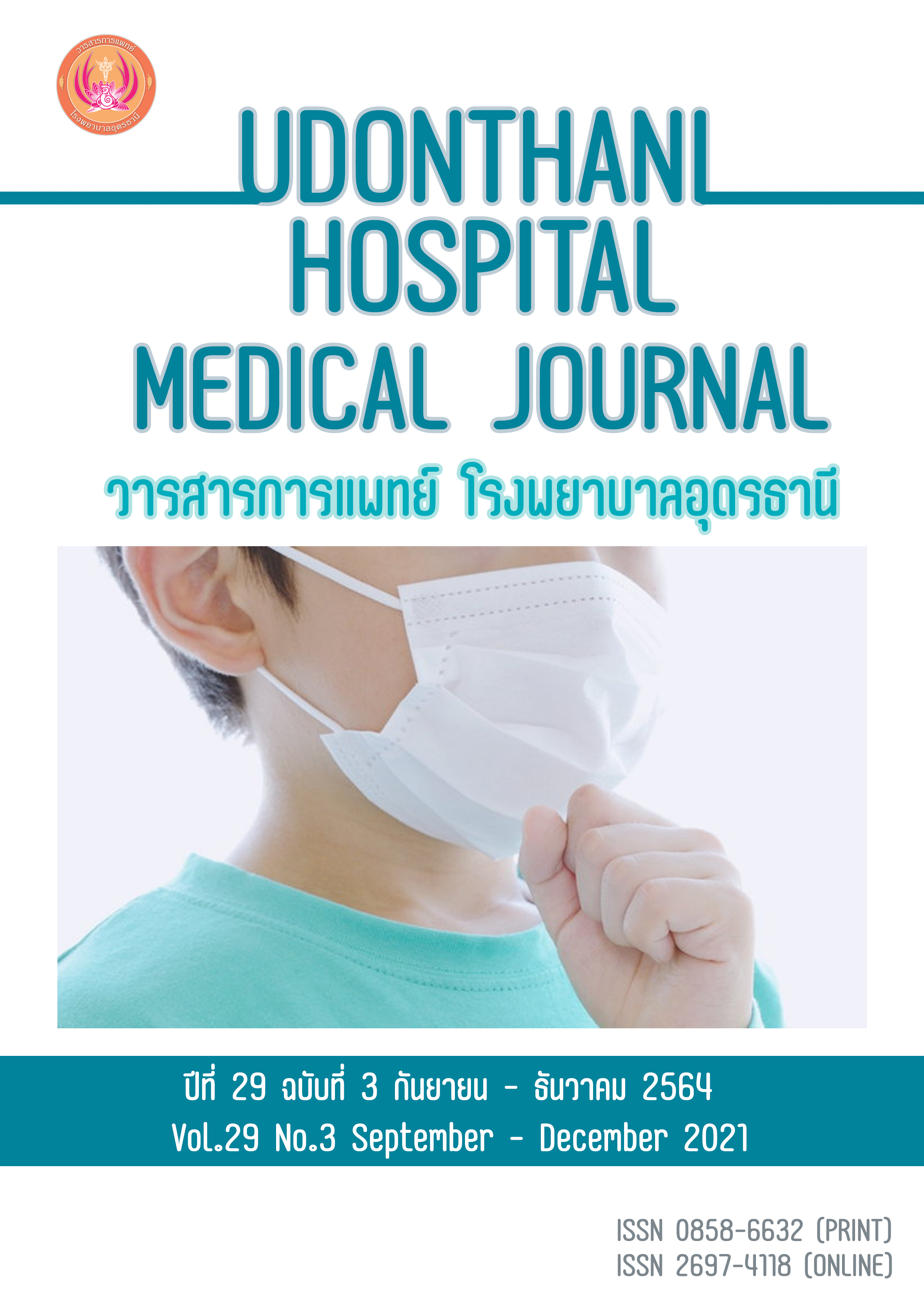ปัจจัยที่ส่งผลทำให้ผลการรักษาโรคเมลิออยโดสิสล้มเหลวในโรงพยาบาลเพ็ญจังหวัดอุดรธานี
คำสำคัญ:
เมลิออยโดสิส, การรักษาล้มเหลวบทคัดย่อ
โรคเมลิออยโดสิสเป็นโรคที่พบได้บ่อยในประเทศไทย โดยเฉพาะในภาคอีสาน มีหลายครั้งที่ผู้ป่วยได้รับยาปฏิชีวนะรักษาที่เหมาะสมแล้ว แต่ผลการรักษายังคงล้มเหลว การศึกษานี้มีวัตถุประสงค์เพื่อศึกษาหาปัจจัยที่ส่งผลทำให้ผลการรักษาโรคเมลิออยโดสิสล้มเหลว ซึ่งเป็นการศึกษาวิจัยเชิงพรรณนาแบบย้อนหลัง เก็บข้อมูลจากเวชระเบียนผู้ป่วยในที่เข้ารับการรักษาในโรงพยาบาลเพ็ญ จังหวัดอุดรธานี ที่ได้รับการวินิจฉัยว่าเป็นโรคเมลิออยโดสิส โดยมีหลักฐานการวินิจฉัยจากการตรวจพบเชื้อทางจุลชีววิทยา ระหว่างวันที่ 1 ตุลาคม พ.ศ. 2559 ถึง 30 กันยายน 2563 โดยข้อมูลจะถูกนำมาวิเคราะห์ทางสถิติ logistic regression เพื่อหาปัจจัยดังกล่าวกำหนดค่านัยสำคัญทางสถิติที่ 0.05
ผลการวิจัย ในช่วงระยะเวลาที่ทำการศึกษามีผู้ป่วยที่ได้รับการวินิจฉัยว่าเป็นโรคเมลิออยโดสิสจากการตรวจพบเชื้อทางจุลชีววิทยา 97 ราย เสียชีวิตทั้งหมด 4 ราย มี 2 ราย เสียชีวิตหลังการรักษาน้อยกว่า 48 ชั่วโมงจึงถูกคัดออกจากการศึกษา เหลือผู้ป่วยเข้าการศึกษาทั้งหมด 95 ราย เป็นเพศชายร้อยละ 65.3 เมื่อเปรียบเทียบกลุ่มที่มีผลการรักษาล้มเหลวกับกลุ่มที่มีผลการรักษาดีพบว่า ผู้ป่วยปอดอักเสบติดเชื้อ (ร้อยละ 58.1 และร้อยละ 9.6) มีภาวะช็อกจากการติดเชื้อตั้งแต่แรกรับ (ร้อยละ 41.9 และร้อยละ 15.4) และได้รับยาปฏิชีวนะไม่เหมาะสม (ร้อยละ 11.6 และร้อยละ 0.0) ในกลุ่มที่รักษาล้มเหลวสูงกว่ากลุ่มที่มีผลการรักษาดีอย่างมีนัยสำคัญทางสถิติ (p < 0.001, p = 0.004, p = 0.017) และได้รับยา ceftazidime น้อยกว่ากลุ่มที่มีผลการรักษาดีอย่างมีนัยสำคัญทางสถิติ (ร้อยละ 76.7 และ 92.3 p = 0.033) โรคประจำตัวของผู้ป่วยหรือการติดเชื้อในกระแสเลือดไม่มีความแตกต่างกันอย่างมีนัยสำคัญทางสถิติ
จากการทำ multivariate analysis พบว่ามีปัจจัยที่มีผลต่อการรักษาล้มเหลวอย่างมีนัยสำคัญทางสถิติได้แก่ มีปอดอักเสบติดเชื้อ (Adjusted OR 23.99, 95%CI 5.96-96.48, p < 0.001), มีการติดเชื้อของกระดูกและข้อ (Adjusted OR 23.76, 95%CI 3.34-169.04, p = 0.002), ติดเชื้อในช่องท้อง (Adjusted OR 14.05, 95%CI 2.19-89.96, p = 0.005) และมีภาวะช็อกจากการติดเชื้อตั้งแต่แรกรับ (Adjusted OR 8.38, 95%CI 2.04-34.40, p = 0.003)
สรุป ปัจจัยที่ส่งผลทำให้ผลการรักษาโรคเมลิออยโดสิสล้มเหลวคือปอดอักเสบติดเชื้อ ติดเชื้อของกระดูกและข้อ ติดเชื้อในช่องท้อง และการมีภาวะช็อกจากการติดเชื้อตั้งแต่แรกรับ
เอกสารอ้างอิง
2. Chaowagul W, White NJ, Dance DA, Wattanagoon, Y, Naigowit P, Davis, TM, et al. Melioidosis: a major cause of community-acquired septicemia in northeastern Thailand. J Infect Dis 1989; 159(5): 890-9.
3. Currie BJ, Fisher DA, Howard DM, Burrow, J N., Selvamyagam, S. Snellinlg P L.,et al. The epidemiology of melioidosis in Australia and Papua New Guinea. Acta Trop 2000; 74(2-3): 121-7.
4. Leelarasamee A, Bovornkitti S. Melioidosis: review and update. Rev Infect Dis 1989; 11(3): 413-25.
5. Brundage WG, Thuss CJ, Jr., Walden DC. Four fatal cases of melioidosis in U. S. soldiers in Vietnam. Bacteriologic and pathologic characteristics. The American journal of tropical medicine and hygiene 1968; 17(2): 183-91.
6. Mackowiak PA, Smith JW. Septicemic melioidosis. Occurrence following acute influenza A six years after exposure in Vietnam. Jama 1978;240(8):764-6.
7. Dance DA. Ecology of Burkholderia pseudomallei and the interactions between environmental Burkholderia spp. and human-animal hosts. Acta Trop 2000; 74(2-3): 159-68.
8. Kunakorn M, Jayanetra P, Tanphaichitra D. Man-to-man transmission of melioidosis. Lancet (London, England) 1991; 337(8752): 1290-1.
9. Suputtamongkol Y, Chaowagul W, Chetchotisakd P, Lertpatanasuwun, N, Intaranongpai, S, Ruchutrakool, T, et al. Risk factors for melioidosis and bacteremic melioidosis. Clinical infectious diseases : an official publication of the Infectious Diseases Society of America 1999; 29(2): 408-13.
10. Menon R, Baby P, Kumar VA, Surendran, S., Pradeep, M., Rajendran, A, et al. Risk Factors for Mortality in Melioidosis: A Single-Centre, 10-Year Retrospective Cohort Study. The Scientific World Journal 2021;2021:8154810.
11. White NJ, Dance DA, Chaowagul W, Wattanagoon Y, Wuthiekanun V, Pitakwatchara N. Halving of mortality of severe melioidosis by ceftazidime. Lancet (London, England) 1989; 2(8665): 697-701.
12. Sookpranee M, Boonma P, Susaengrat W, Bhuripanyo K, Punyagupta S. Multicenter prospective randomized trial comparing ceftazidime plus co-trimoxazole with chloramphenicol plus doxycycline and co-trimoxazole for treatment of severe melioidosis. Antimicrobial agents and chemotherapy 1992; 36(1): 158-62.
13. Simpson AJ, Suputtamongkol Y, Smith MD, Angus, B J, Rajanuwong, A, Wuthiekanun, V, et al. Comparison of imipenem and ceftazidime as therapy for severe melioidosis. Clinical infectious diseases: an official publication of the Infectious Diseases Society of America 1999; 29(2): 381-7.
14. Stephens DP, Thomas JH, Ward LM, Currie BJ. Melioidosis Causing Critical Illness: A Review of 24 Years of Experience From the Royal Darwin Hospital ICU. Crit Care Med 2016; 44(8): 1500-5.
15. Chaowagul W, Suputtamongkol Y, Dance DA, Rajchanuvong A, Pattara-arechachai J, White NJ. Relapse in melioidosis: incidence and risk factors. J Infect Dis 1993; 168(5): 1181-5.
16. Limmathurotsakul D, Chaowagul W, Chierakul W, Stepniewska, K, Maharjan, B, Wuthiekanun, V, et al. Risk factors for recurrent melioidosis in northeast Thailand. Clinical infectious diseases: an official publication of the Infectious Diseases Society of America 2006; 43(8): 979-86.
17. Suputtamongkol Y, Dance DA, Chaowagul W, Wattanagoon Y, Wuthiekanun V, White NJ. Amoxycillin-clavulanic acid treatment of melioidosis. Trans R Soc Trop Med Hyg 1991; 85(5): 672-5.
18. Dance D. Treatment and prophylaxis of melioidosis. Int J Antimicrob Agents 2014; 43(4): 310-8.
19. Currie BJ. Melioidosis: evolving concepts in epidemiology, pathogenesis, and treatment. Semin Respir Crit Care Med 2015; 36(1): 111-25.
20. Churuangsuk C, Chusri S, Hortiwakul T, Charernmak B, Silpapojakul K. Characteristics, clinical outcomes and factors influencing mortality of patients with melioidosis in southern Thailand: A 10-year retrospective study. Asian Pac J Trop Med 2016; 9(3): 256-60.
21. Chierakul W, Anunnatsiri S, Short JM, Maharjan, B, Mootsikapun, A, Simpson, A, et al. Two randomized controlled trials of ceftazidime alone versus ceftazidime in combination with trimethoprim-sulfamethoxazole for the treatment of severe melioidosis. Clinical infectious diseases: an official publication of the Infectious Diseases Society of America 2005; 41(8): 1105-13.
22. Hoffmaster AR, AuCoin D, Baccam P, Baggett, H, Baird, Rob, Bhengsri, S., et al. Melioidosis diagnostic workshop, 2013. Emerg Infect Dis 2015; 21(2): e141045.
23. Bhengsri S, Baggett HC, Jorakate P, Kaewpan, A, Prapasiri, P, Naorat, S., et al. Incidence of bacteremic melioidosis in eastern and northeastern Thailand. The American journal of tropical medicine and hygiene 2011; 85(1): 117-20.
24. Limmathurotsakul D, Peacock SJ. Melioidosis: a clinical overview. British medical bulletin 2011; 99: 125-39.
25. Limmathurotsakul D, Wongratanacheewin S, Teerawattanasook N, Wongsuvan, G, Chaisuksant, S, Chetchotisakd, P., et al. Increasing incidence of human melioidosis in Northeast Thailand. The American journal of tropical medicine and hygiene 2010; 82(6): 1113-7.
26. Currie BJ, Ward L, Cheng AC. The epidemiology and clinical spectrum of melioidosis: 540 cases from the 20 year Darwin prospective study. PLoS neglected tropical diseases 2010; 4(11): e900.
ดาวน์โหลด
เผยแพร่แล้ว
รูปแบบการอ้างอิง
ฉบับ
ประเภทบทความ
สัญญาอนุญาต
การละเมิดลิขสิทธิ์ถือเป็นความรับผิดชอบของผู้ส่งบทความโดยตรง
ผลงานที่ได้รับการตีพิมพ์ถือเป็นลิขสิทธิ์ของผู้นิพนธ์ ขอสงวนสิทธิ์มิให้นำเนื้อหา ทัศนะ หรือข้อคิดเห็นใด ๆ ของบทความในวารสารไปเผยแพร่ทางการค้าก่อนได้รับอนุญาตจากกองบรรณาธิการ อย่างเป็นลายลักษณ์อักษร



